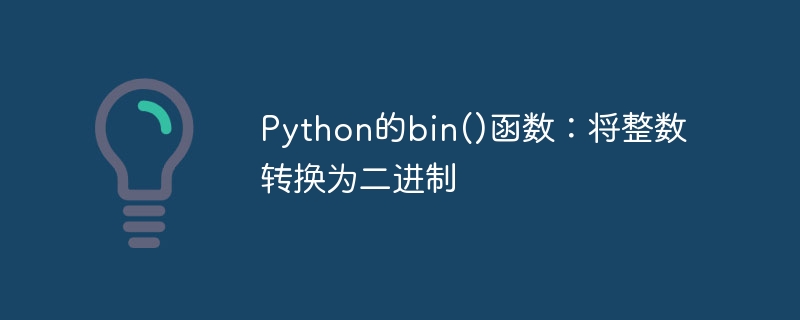

Python's bin() function: Convert integers to binary
In Python programming, the need to convert integers to binary is often involved. The bin() function in Python is a quick and easy way to achieve this goal.
The basic syntax of the bin() function is:
bin(number)
Where, number is an integer, and the function will return the binary representation of the integer.
Below, I will introduce the use of bin() function in detail and provide some specific code examples.
num = 10
binary = bin(num)
print(binary)
In the above In the code, we convert the integer 10 to binary and store the result in the variable binary. Then, print the result through the print() function. Note that the bin() function returns a string, starting with '0b' indicates that it is a binary number.
num = 10
binary = bin(num)[2:]
print(binary)
In this example, we use the slicing operation bin(num)[2:] to remove the first two characters '0b' from the result and obtain a binary string without prefix.
num = 10
binary = bin(num)[2:].zfill(8)
print(binary)
In the above code, we use the zfill() method to fill the binary string to 8 digits. Assuming that the converted binary number has less than 8 digits, it is padded with 0s on the left.
num = -10
binary = bin(num)
print(binary)
If we don't want the negative sign prefix to be included in the result, we can use the slicing operation to remove it.
To sum up, Python’s bin() function is a very convenient way to convert integers to binary. It provides a simple syntax and can customize the format of the results with some additional operations.
I hope that through the introduction of this article, you will have a clearer understanding of the use of the bin() function and be able to better apply it in actual projects. I wish everyone can write more efficient Python programs!
The above is the detailed content of Python's bin() function: Convert integer to binary. For more information, please follow other related articles on the PHP Chinese website!
 The main reason why computers use binary
The main reason why computers use binary
 Binary representation of negative numbers
Binary representation of negative numbers
 How to represent negative numbers in binary
How to represent negative numbers in binary
 binary arithmetic
binary arithmetic
 Common tools for software testing
Common tools for software testing
 What is the difference between webstorm and idea?
What is the difference between webstorm and idea?
 clonenode usage
clonenode usage
 Virtual mobile phone number to receive verification code
Virtual mobile phone number to receive verification code




